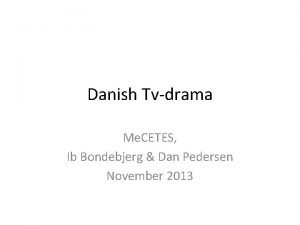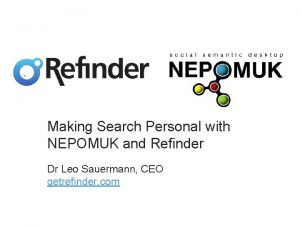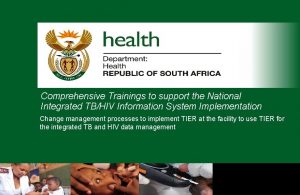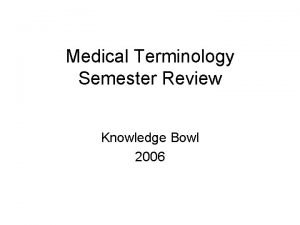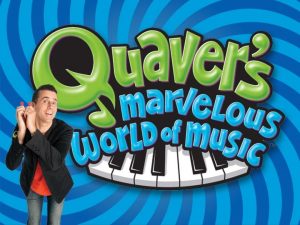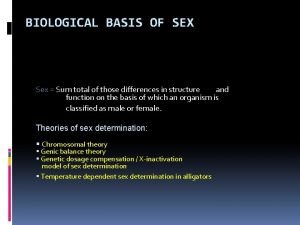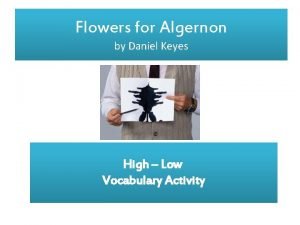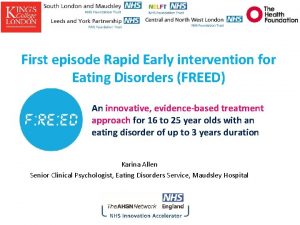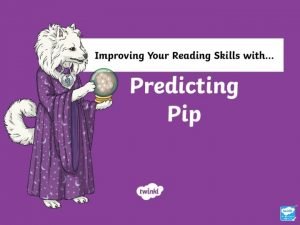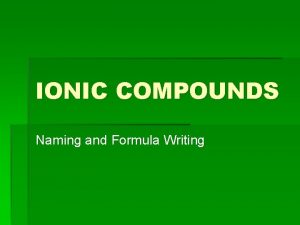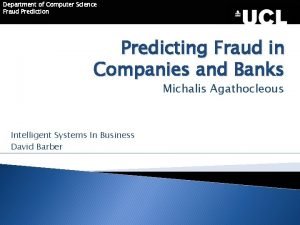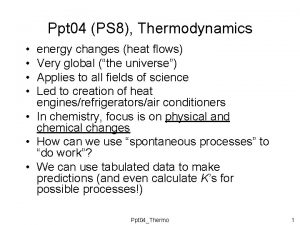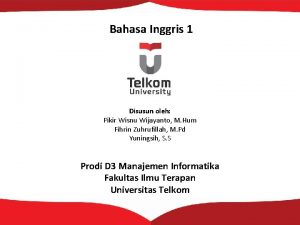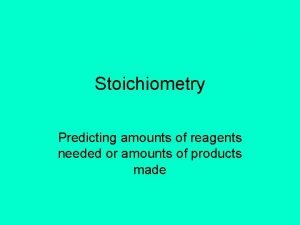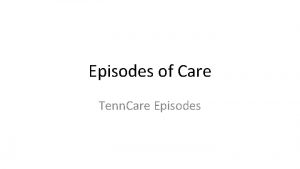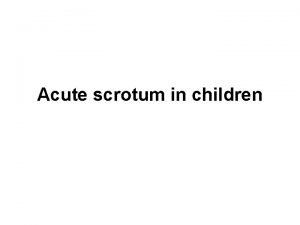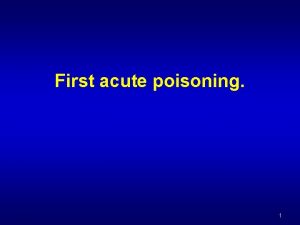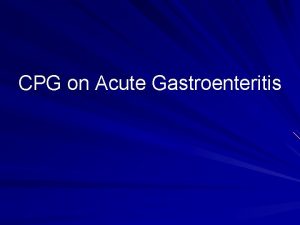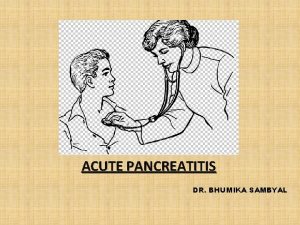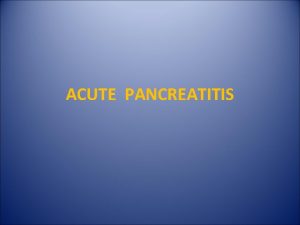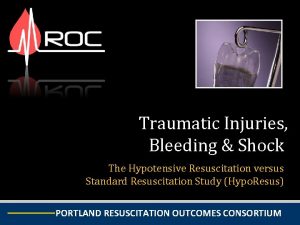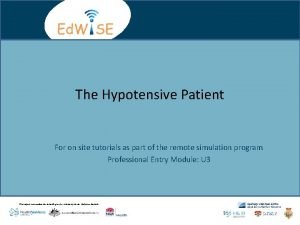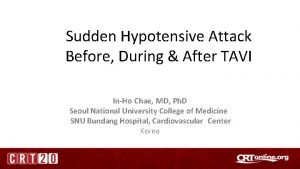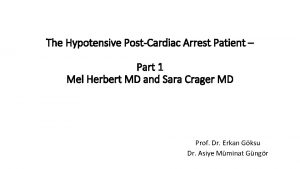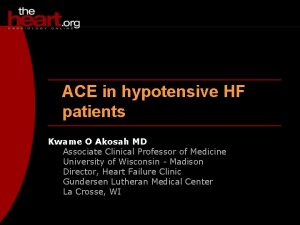Predicting Acute Hypotensive Episodes The 10 th Annual



















- Slides: 19

Predicting Acute Hypotensive Episodes The 10 th Annual Physio. Net/Computers in Cardiology Challenge George B. Moody and Li-wei H. Lehman Massachusetts Institute of Technology, Cambridge, MA, USA

Physio. Net/Cin. C Challenges Open engineering challenges aimed at stimulating research on questions of basic or clinical interest Physio. Net provides data to support study of challenge problems Cin. C provides a forum to discuss solutions Annual series began in 2000 for Cin. C in Boston

Acute hypotension in the ICU Among the most critical events, leading to irreversible organ damage and death if untreated Causes include sepsis, MI, cardiac arrhythmia, pulmonary embolism, hemorrhage, dehydration, anaphylaxis, effects of medication, other causes of hypovolemia, insufficient CO, or vasodilatory shock Requires rapid and appropriate intervention

Why is prediction important? Early warning of impending events * should result in increased vigilance, which * may lead to diagnosis of underlying conditions * may offer an opportunity to avoid or mitigate events * may offer an opportunity to plan interventions * may lead to better care and outcome for at-risk patients Forecasting need not be perfect to be useful!

Acute Hypotensive Episode (AHE) MAP (1 -minute averages of arterial blood pressure waveform) 30 minutes 60 mm. Hg ≤ 10% outliers AHE Definition: An AHE is at least 30 minutes long, with 10 mm. Hg ≤ MAP ≤ 60 mm. Hg for ≥ 90% of any 30 -minute interval within the episode.

The Challenge Problem Identify ICU patients at elevated risk of AHE In this challenge: given at least 10 hours of each case, forecast if an AHE will occur in the next hour

Data for the Challenge Selected MIMIC II Database patient records: ECG, ABP waveforms, usually others Heart rate, mean/systolic/diastolic BP time series Clinical data (medications, fluids, lab results) Each record covers a complete ICU stay (typically a few days, often longer) Training data: complete patient records Test data: truncated patient records

Segmentation of test records

Training Set Complete patient records with known classifications, T 0 specified for each record: 15 with AHEs from patients given pressors* 15 with AHEs from patients not given pressors 15 from patients without documented AHEs 15 from patients with AHEs not in the prediction window, including some who were given pressors * pressors: dobutamine, dopamine, isoproterenol, epinephrine, norepinephrine, phenylephrine, vasopressin

Test Sets Patient record segments 'a' and 'b' (at least 10 hours, ending at T 0): Test set A (event 1): 10 records of patients given pressors 5 with AHEs in the forecast window (the hour after T 0) 5 without AHEs Test set B (event 2): 40 records of a mixed group of patients (including some given pressors) 14 with AHEs in the hour after T 0 26 without AHEs

Results Event 1: Perfect classification (10/10) by Chen, Wessel, Malberg, Yan, Jousset, Chiarugi, Henriques, Jin, Minhas, Ho, Fournier, Mneimneh, Hayn Event 2: Best results 37/40 (1 FN, 2 FP) by Henriques; 36/40 by Chen, Mneimneh

Difficult cases: missed predictions Records with AHE: 224 (missed in 15 of the top 20 entries) rapid onset of AHE after 35 minutes, MAP = 45 mm. Hg at 56 minutes 222 (missed in 12 of the top 20 entries) pattern of gradual decline in MAP treated by fluid bolus followed by sharp rise and rapid decline to 63 -70 mm. Hg occurs several times in segment 'b'; in segment 'c', decline goes eventually to 54 mm. Hg in an AHE that starts after 25 minutes

Difficult cases: false predictions Records without AHE: 227 (AHE forecast in 18 of the top 20 entries) MAP is steady at 62 -63 mm. Hg for most of the hour, dips below 60 for about 15 minutes after the end of the window 222 (AHE forecast in 13 of the top 20 entries) MAP is stable for 72 minutes, then drops sharply into the acute hypotensive range With a less restrictive AHE definition, these might have been called true positives.

Discussion Forecasting need not be perfect to be useful, but most of the participants achieved results that exceeded our expectations Excellent forecasting is possible using the ABP signal or the MAP time series alone, but use of other information should help to inform the interpretation of the ABP (or the identification of the underlying cause of AHE) and may permit robust AHE forecasting when MAP is unreliable or unavailable – a topic for future work

Discussion Combination of algorithms may permit further improvements. For example, combining top 3 (Chen, Henriques, and Mneimneh): * If any of 3 predicts AHE, we can find all AHE in test sets (with 5 false positives) * If all of 3 predict AHE, we can find all non-AHE in test sets (with 2 false negatives) (and since all three are open-source algorithms, these combinations can be tested on other data to see if the findings hold)

Thank you! Participants in the Challenge Special thanks to Franco Chiarugi for exceptionally useful feedback Colleagues in the Physio. Net and MIMIC II projects The family of Solange Akselrod for a generous contribution to the award fund

Further information, access to the Challenge data sets, reference classifications, contributed open source entries, information about past Challenges, and (coming soon) the announcement of next year's Challenge: http: //physionet. org/challenge/

Physio. Net Resource for biomedical research, established in 1999 by a collaboration of researchers at MIT, Harvard, BU, and Mc. Gill Provides free web access to large collections of physiologic signals and time series, and related open-source software NIH funded via NIBIB, NIGMS (U 01 -EB-008577)

Challenge events Event 1: Identify which 5 patients in test set A experienced an AHE during the forecast window, and which 5 did not. Event 2: Identify which 10 to 16 patients in test set B experienced an AHE during the forecast window, and which 24 to 30 did not. Entries were ranked by the fraction of records correctly classified.
 Parade's end episodes
Parade's end episodes Big bang theory episodes
Big bang theory episodes Jonathan schultz jenny jones
Jonathan schultz jenny jones The daily episodes from
The daily episodes from Myocele medical term
Myocele medical term Quavers wonderful world of music
Quavers wonderful world of music Argumentum verbo sum
Argumentum verbo sum Flowers for algernon characterization
Flowers for algernon characterization Parallel episodes in flowers for algernon
Parallel episodes in flowers for algernon Intervention anorexia episodes
Intervention anorexia episodes Symbols in the kite runner
Symbols in the kite runner Social episodes are
Social episodes are Predicting products of chemical reactions
Predicting products of chemical reactions Predicting pip
Predicting pip Predicting and naming ionic compounds
Predicting and naming ionic compounds Predicting fraud
Predicting fraud 6 manipulative skills
6 manipulative skills Predicting spontaneity
Predicting spontaneity Bahasa inggris disusun
Bahasa inggris disusun How to determine if a single replacement reaction occurs
How to determine if a single replacement reaction occurs
